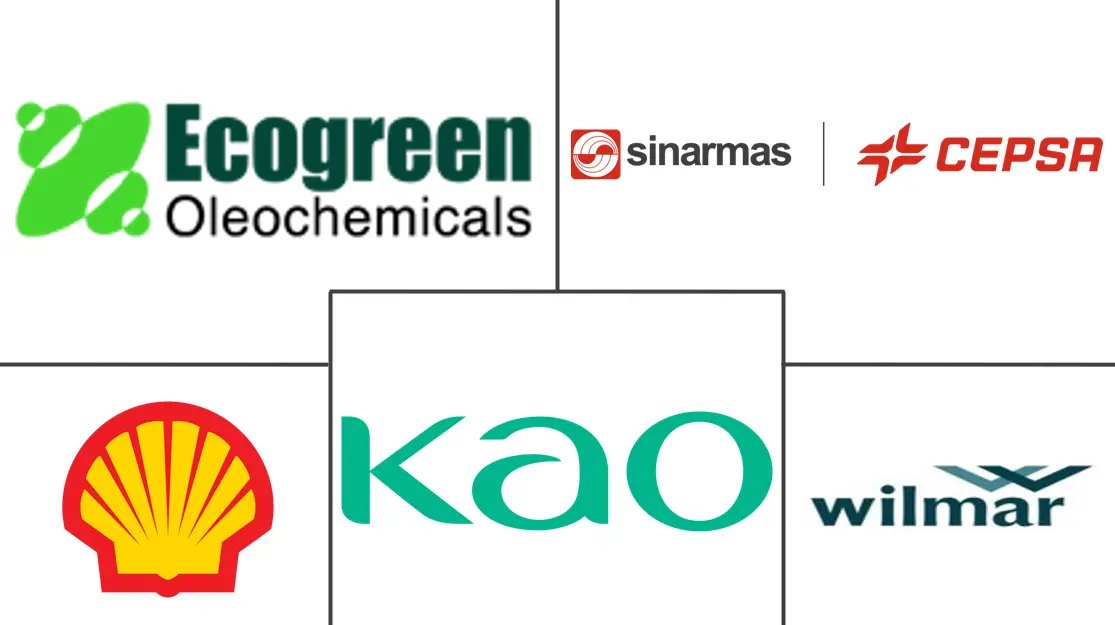Fatty Alcohol Market Size and Share
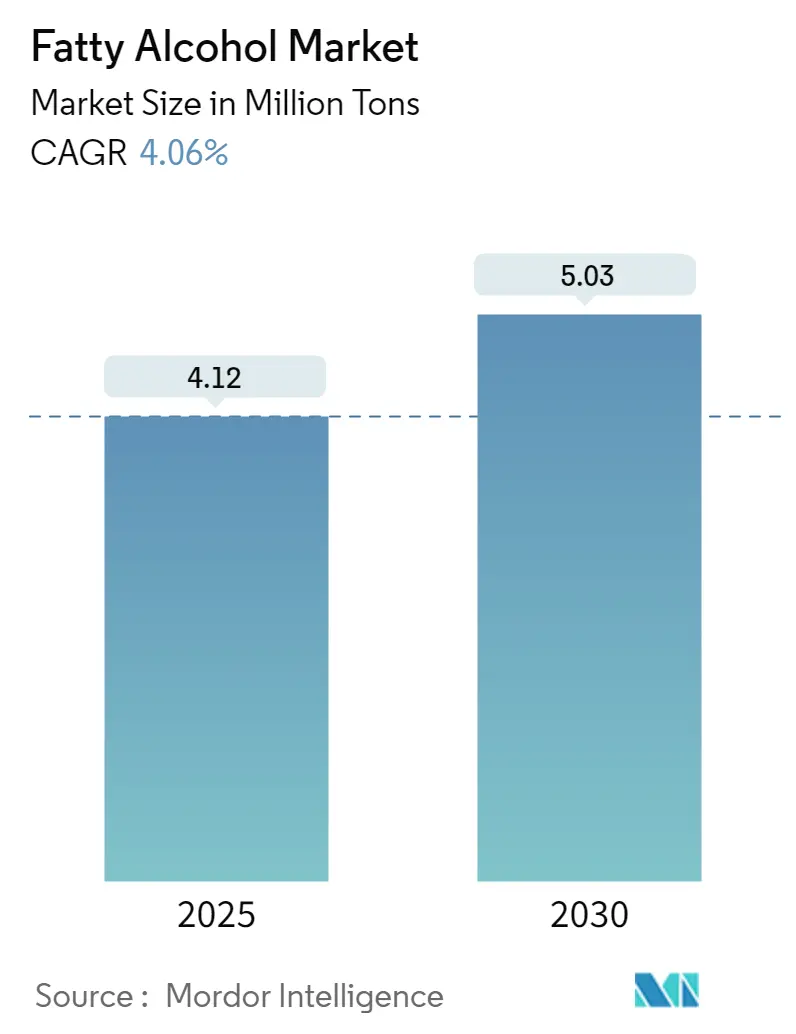
Fatty Alcohol Market Analysis by Mordor Intelligence
The Fatty Alcohol Market size is estimated at 4.12 million tons in 2025, and is expected to reach 5.03 million tons by 2030, at a CAGR of 4.06% during the forecast period (2025-2030).
The fatty alcohol industry is experiencing significant transformation driven by sustainability initiatives and technological advancements in manufacturing processes. Major industry players are increasingly investing in bio-based production capabilities, with companies like Sinarmas Cepsa Pte Ltd (SCPL) expanding their production capacity of bio-based chemicals, including fatty alcohols, at their Indonesian facility in November 2022. This shift towards sustainable production methods is reshaping the industry's supply chain dynamics and manufacturing protocols, as companies aim to reduce their environmental footprint while maintaining product quality and performance.
The market is witnessing substantial developments in end-use applications, particularly in the cleaning and hygiene sector. According to industry data, the European household care and professional cleaning and hygiene sector reached a significant market value of EUR 42.8 billion in 2022, demonstrating the robust demand for fatty alcohol-based products in cleaning applications. The industry is experiencing a notable shift towards concentrated formulations and eco-friendly products, driving innovations in fatty alcohol-based surfactants and detergents.
Raw material sourcing and supply chain optimization have become critical focus areas for industry stakeholders. Companies are diversifying their feedstock sources and implementing advanced processing technologies to enhance production efficiency. The integration of digital technologies and automation in manufacturing processes is enabling better quality control and operational efficiency, while also helping manufacturers adapt to fluctuating market demands and raw material availability.
The industry landscape is being reshaped by strategic partnerships and capacity expansions. In the personal care sector, Italy's cosmetics industry achieved a total turnover of EUR 13.3 billion in 2022, highlighting the growing demand for fatty alcohol-based ingredients in cosmetic formulations. Manufacturers are increasingly focusing on developing specialized grades of fatty alcohols to meet the specific requirements of different applications, while also investing in research and development to improve product performance and sustainability profiles. The industry is witnessing a trend towards vertical integration, with companies expanding their presence across the value chain to ensure better control over raw material supplies and end-product quality.
Global Fatty Alcohol Market Trends and Insights
Growing Demand from Pharmaceutical Industry
Fatty alcohols are increasingly becoming crucial components in pharmaceutical formulations due to their unique properties as excipients and permeation enhancers. These alcohols are abundantly used in various pharmaceutical formulations that are heterogeneous semisolid systems, where the drug is either dissolved or dispersed in water-in-oil or oil-in-water emulsions. The versatility of fatty alcohols in pharmaceutical applications extends to their use as stabilizing agents, building agents, counterions, and pH modifiers. Some of the most studied fatty alcohols for drug formulations include ceteostearyl alcohol 50, ceteostearyl alcohol 70, cetyl alcohol, and stearyl alcohol, which are extensively used in cream preparation formulas.
The pharmaceutical industry's robust growth and increasing investments in research and development are driving the demand for fatty alcohols. For instance, China's pharmaceutical sector, which comprises approximately 5,000 manufacturers as of 2022, demonstrates the scale of potential demand for pharmaceutical excipients including fatty alcohols. The industry is witnessing significant expansion in research and development activities, with major pharmaceutical companies investing heavily in innovation. According to Evaluate Pharma, in 2022, major pharmaceutical companies, including F. Hoffmann-La Roche Ltd, Pfizer, Bristol-Myers Squibb Company, and AstraZeneca, invested a total of USD 104 billion in research and development, indicating substantial potential for increased fatty alcohol consumption in pharmaceutical formulations.
Increasing Usage of Fatty Alcohol in Personal Care and Cosmetics Products
The personal care and cosmetics industry represents a significant driver for fatty alcohol market demand, with these compounds being essential ingredients in various formulations ranging from skincare products to hair care solutions. Fatty alcohols serve multiple functions in personal care products, acting as emollients, emulsifiers, and thickeners in cosmetics and various other end-user industries. The growing consumer awareness about personal hygiene and beauty products has led to increased demand for sophisticated formulations that utilize fatty alcohols for their unique properties. This is evidenced by the substantial market values in key regions, with China's beauty and personal care market generating USD 55.3 billion in 2022, and India's personal hygiene market projected to reach USD 15 billion by the end of 2023.
The expansion of the personal care industry is further demonstrated by significant developments in various markets. For instance, India's hair care market is expected to reach USD 4.89 billion with a CAGR of 6.6% in the next two years, indicating growing demand for fatty alcohol-based formulations in hair care products. Additionally, the establishment of the Japan Cosmetic Industry Association (JCIA) in April 2023, through the integration of multiple regional associations, represents institutional support for industry growth, with the Japanese cosmetic market already showing strong performance with over 3% growth in 2022. The increasing sophistication of personal care products and the growing demand for natural and effective ingredients continue to drive innovation in fatty alcohol market applications within this sector.
Segment Analysis: Type
Natural Sources Segment in Fatty Alcohol Market
Natural sources dominate the global fatty alcohol market, commanding approximately 76% of the total market share in 2024. These fatty alcohols are primarily derived from natural fats and oils, including coconut, palm, palm kernel, and rapeseed, through a process of hydrogenating the corresponding fatty methyl ester followed by subsequent fractionation. The segment's dominance is attributed to the increasing consumer preference for naturally sourced ingredients, particularly in personal care and cosmetic applications. Natural fatty alcohols are extensively used in various applications due to their biodegradability and renewable source origin, making them environmentally sustainable alternatives. The growing emphasis on sustainable and eco-friendly products across industries, coupled with stringent regulations promoting bio-based materials, has further strengthened the position of natural source fatty alcohols in the global market.
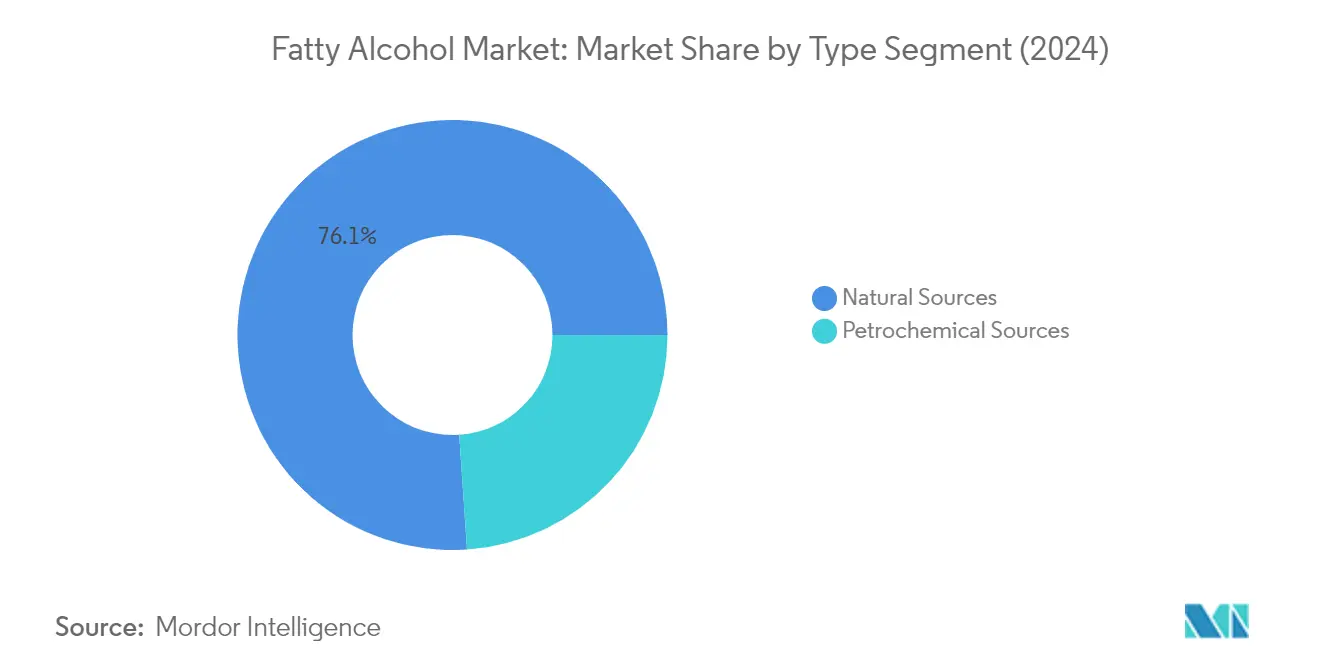
Petrochemical Sources Segment in Fatty Alcohol Market
The petrochemical sources segment is projected to experience the fastest growth in the fatty alcohol market, with an expected growth rate of approximately 4% during the forecast period 2024-2029. This growth is primarily driven by the segment's ability to offer consistent quality and scalable production capabilities. Petrochemical-based fatty alcohols are manufactured through synthetic pathways, particularly the Ziegler process, where ethylene is oligomerized using a triethylaluminium catalyst followed by air oxidation. The segment's growth is further supported by technological advancements in production processes, which have led to improved efficiency and reduced environmental impact. Recent studies have indicated that synthetic fatty alcohols can demonstrate lower average greenhouse gas emissions compared to some natural alternatives, making them increasingly attractive for various industrial applications where sustainability metrics are becoming crucial considerations.
Segment Analysis: Application
Surfactant Segment in Fatty Alcohol Market
The surfactant segment dominates the global fatty alcohol market, accounting for approximately 57% of the total market share in 2024. Due to their amphipathic nature, fatty alcohols behave as nonionic surfactants and are extensively used in the manufacturing of laundry detergent, dishwashing detergent, and other household cleaning products. The segment's dominance is particularly evident in the Asia-Pacific region, where countries like China and India are experiencing substantial growth in surfactant demand. Major manufacturers are focusing on developing bio-based surfactants to meet the growing consumer preference for sustainable products. The segment's growth is further supported by increasing urbanization, rising disposable incomes, and growing awareness about hygiene and cleanliness across both developed and developing regions.
Personal Care Segment in Fatty Alcohol Market
The personal care segment is projected to exhibit the highest growth rate of approximately 5% during the forecast period 2024-2029. This growth is primarily driven by the increasing demand for fatty alcohols in various cosmetic and personal care applications, where they function as emollients, emulsifiers, and thickening agents. The segment's expansion is supported by the rising consumer focus on personal grooming, growing preference for natural and organic personal care products, and increasing disposable income in emerging economies. Major personal care manufacturers are increasingly incorporating fatty alcohols into their formulations due to their excellent moisturizing properties and skin compatibility. The segment is witnessing significant innovation in terms of product development, with manufacturers focusing on developing specialized fatty alcohol derivatives for specific personal care applications.
Remaining Segments in Application Segmentation
The pharmaceutical, lubricants, foods, and other applications segments collectively constitute a significant portion of the fatty alcohol market. The pharmaceutical segment utilizes fatty alcohols as excipients in various formulations and as permeation enhancers for drug delivery systems. In the lubricants sector, fatty alcohols serve as viscosity modifiers and stabilizers in various industrial applications. The food segment employs fatty alcohols as emulsifiers and thickening agents in food processing. Other applications include textiles, paper processing, and construction industries, where fatty alcohols are used in various specialized applications such as concrete additives and textile processing aids. These segments continue to provide steady growth opportunities, driven by technological advancements and expanding application scope across different industries.
Fatty Alcohol Market Geography Segment Analysis
Fatty Alcohol Market in Asia-Pacific
The Asia-Pacific region represents a dominant force in the global fatty alcohol market, driven by robust demand across various industries, including surfactants, personal care and cosmetics, pharmaceuticals, and lubricants. The region's market landscape is characterized by the presence of major manufacturing facilities and a strong raw material supply chain, particularly in countries like China, India, Japan, and South Korea. The growing industrialization, increasing disposable income, and rising awareness about personal hygiene products have contributed significantly to the fatty alcohol market expansion in this region.
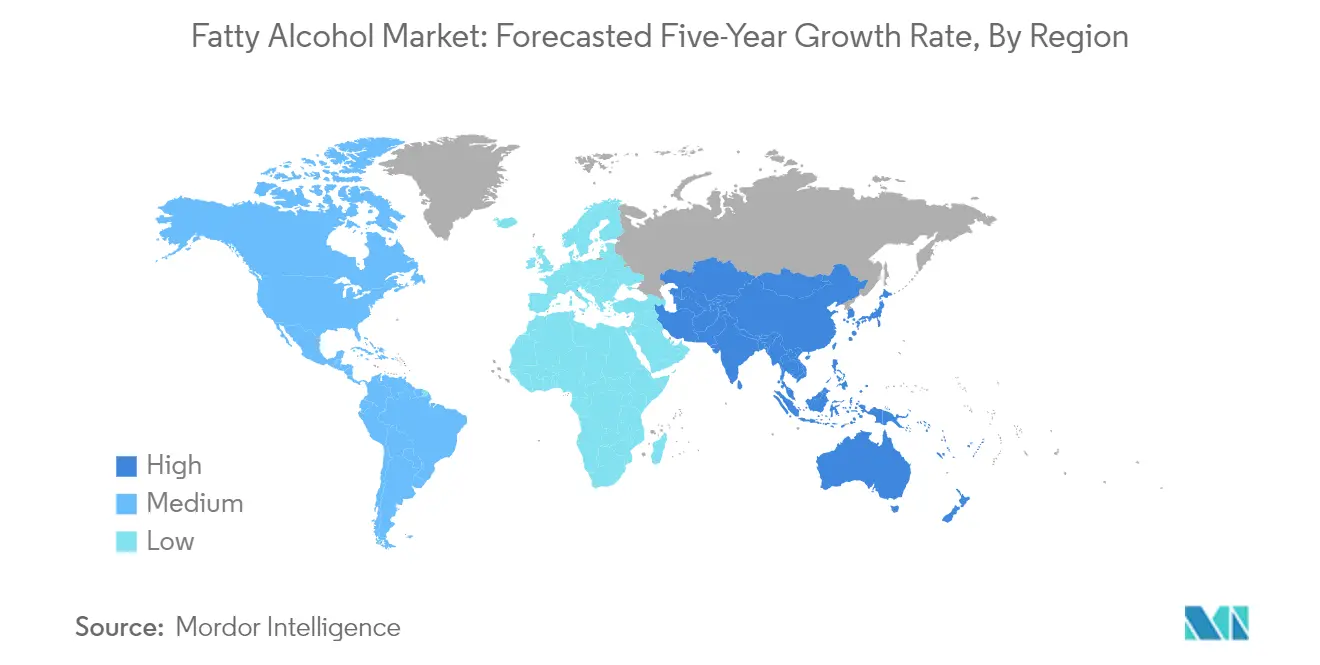
Fatty Alcohol Market in China
China stands as the largest market for fatty alcohols in the Asia-Pacific region, holding approximately 43% of the regional market share. The country's dominance is supported by its extensive manufacturing infrastructure, with over 60 washing, care, and cleaning agent manufacturers operating in the market. The presence of a robust chemical industry, coupled with increasing domestic demand from various end-use sectors, particularly in soaps, detergents, and personal care products, continues to drive market growth. The high penetration of washing machines, with approximately 98.7 machines per hundred households, further strengthens the demand for cleaning products containing fatty alcohols.
Fatty Alcohol Market in India
India emerges as the fastest-growing market in the Asia-Pacific region, with a projected growth rate of approximately 5% during 2024-2029. The country's market expansion is driven by its rapidly growing pharmaceutical and personal care sectors, supported by government initiatives like 'Aatma Nirbhar Bharat' and 'Make in India' programs. India's position as one of the world's major suppliers of generic medicines, accounting for 20% of the global supply by volume, along with its expanding manufacturing capabilities in the personal care sector, creates substantial opportunities for fatty alcohol market consumption. The presence of around 10,500 manufacturing units in the pharmaceutical sector further reinforces the growth trajectory.
Fatty Alcohol Market in North America
The North American fatty alcohol market demonstrates strong market fundamentals, supported by advanced manufacturing capabilities and robust demand from end-use industries. The region benefits from well-established distribution networks and technological advancements in production processes. The United States, Canada, and Mexico form the key markets, with each country contributing significantly to regional growth through their respective industrial sectors, particularly in personal care, pharmaceuticals, and cleaning products.
Fatty Alcohol Market in United States
The United States dominates the North American fatty alcohol market, commanding approximately 76% of the regional market share. The country's leadership position is reinforced by its extensive manufacturing infrastructure, including around 39,646 food and beverage processing plants and numerous pharmaceutical manufacturing facilities. The presence of major multinational companies and a strong focus on research and development in various end-use industries, particularly in the pharmaceutical and personal care sectors, continues to drive market growth.
Fatty Alcohol Market Growth in United States
The United States maintains its position as the fastest-growing market in North America, with an expected growth rate of approximately 4% during 2024-2029. The growth is primarily driven by increasing investments in pharmaceutical research and development, with major pharmaceutical companies investing significantly in R&D activities. The country's robust personal care and cosmetics industry, representing about 20% of the global market and generating around USD 50 billion annually in cosmetic sales, further supports market expansion. The presence of approximately 390 manufacturers of lubricants and other petroleum products adds to the fatty alcohol market's growth potential.
Fatty Alcohol Market in Europe
The European fatty alcohol market is characterized by its mature industrial infrastructure and stringent quality standards. The region's market is driven by strong demand from the personal care, pharmaceutical, and cleaning products sectors. Germany, the United Kingdom, France, and Italy represent the key markets in the region, each contributing significantly to the overall market dynamics through their specialized industrial applications and technological innovations.
Fatty Alcohol Market in Germany
Germany maintains its position as the largest market for fatty alcohols in Europe. The country's market leadership is supported by its strong chemical and manufacturing industry base, particularly in the personal care and pharmaceutical sectors. The presence of over 510 pharmaceutical companies and more than 670 biotechnology companies, coupled with significant investments in research and development, reinforces Germany's dominant position in the regional market.
Fatty Alcohol Market Growth in Germany
Germany continues to demonstrate the strongest growth potential in the European region. The country's market expansion is driven by its leading position in pharmaceutical R&D spending and its robust cosmetics and personal care sector. The presence of over 6,000 companies in the food and beverage industry, along with significant investments in sustainable and bio-based products, contributes to the fatty alcohol market's growth trajectory.
Fatty Alcohol Market in South America
The South American fatty alcohol market demonstrates significant potential, with Brazil and Argentina serving as key markets in the region. The market is characterized by growing demand from personal care, pharmaceutical, and cleaning product sectors. Brazil emerges as both the largest and fastest-growing market in the region, supported by its extensive manufacturing base and increasing investments in various end-use industries. The region's market dynamics are influenced by increasing industrialization and growing consumer awareness about personal care products.
Fatty Alcohol Market in Middle East & Africa
The Middle East & Africa fatty alcohol market shows promising growth potential, with Saudi Arabia and South Africa representing key markets in the region. The market is driven by increasing investments in manufacturing facilities and growing demand from various end-use industries. Saudi Arabia stands out as both the largest and fastest-growing market in the region, supported by its strong industrial base and increasing focus on diversifying its manufacturing capabilities. The region's market development is further supported by growing urbanization and increasing consumer spending on personal care products.
Competitive Landscape
Top Companies in Fatty Alcohol Market
The global fatty alcohol market is characterized by continuous product innovation and operational excellence among leading players like Shell, PT. Ecogreen Oleochemicals, Wilmar International, Kao Corporation, and Sinarmas Cepsa. Companies are increasingly focusing on developing sustainable production methods and expanding their natural-based fatty alcohol portfolios to meet growing consumer demand for eco-friendly products. Strategic capacity expansions, particularly in Asia-Pacific regions with abundant raw material access, demonstrate the industry's commitment to supply chain optimization. Market leaders are strengthening their positions through vertical integration, from raw material sourcing to end-product manufacturing, while also investing in research and development to enhance product quality and application versatility. The emphasis on technological advancement in manufacturing processes and the development of specialized grades for specific applications reflects the industry's evolution towards more sophisticated market offerings.
Fragmented Market with Strong Regional Players
The fatty alcohols market exhibits a partially fragmented structure, characterized by the presence of both global chemical conglomerates and specialized oleochemical manufacturers. Large multinational corporations leverage their extensive distribution networks and diverse product portfolios to maintain market dominance, while regional players capitalize on their local raw material advantages and established customer relationships. The market demonstrates a mix of integrated manufacturers producing fatty alcohol from natural sources like palm kernel oil and coconut oil, alongside petrochemical-based producers, creating a complex competitive landscape with varying value propositions.
Recent market activities indicate a trend toward strategic consolidations, exemplified by moves like KLK OLEO's acquisition of Temix Oleo, highlighting the industry's drive toward market expansion and technological capability enhancement. Companies are increasingly pursuing joint ventures and partnerships to strengthen their market presence, particularly in emerging economies where demand growth is robust. The competitive dynamics are further shaped by backward integration strategies, with several players establishing their own raw material processing capabilities to ensure supply security and cost advantages.
Innovation and Sustainability Drive Future Success
Success in the fatty alcohol industry increasingly depends on companies' ability to align with sustainability trends and develop innovative product solutions. Market leaders are investing in green chemistry initiatives and bio-based raw material sourcing to address growing environmental concerns and regulatory pressures. The development of specialized grades for high-value applications in personal care and pharmaceuticals represents a key differentiation strategy, while operational efficiency and supply chain optimization remain crucial for maintaining competitive cost structures. Companies are also focusing on building stronger relationships with end-users through technical support and customized solutions.
For new entrants and smaller players, success lies in identifying and serving niche market segments while developing unique value propositions. The increasing focus on natural-based products creates opportunities for companies with access to sustainable raw material sources. Regional players can leverage their local market knowledge and agility to respond quickly to changing customer needs, while also investing in research and development to improve product quality and performance. The ability to navigate regulatory requirements, particularly regarding environmental standards and product safety, will become increasingly important for maintaining market position and accessing new opportunities. The detergent alcohol market is also witnessing similar trends, with companies focusing on eco-friendly formulations to cater to consumer preferences.
Fatty Alcohol Industry Leaders
-
PT. Ecogreen Oledochemicals
-
Shell PLC
-
Kao Corporation
-
Wilmar International Ltd
-
Sinarmad Cepsa Pte. Ltd.
- *Disclaimer: Major Players sorted in no particular order
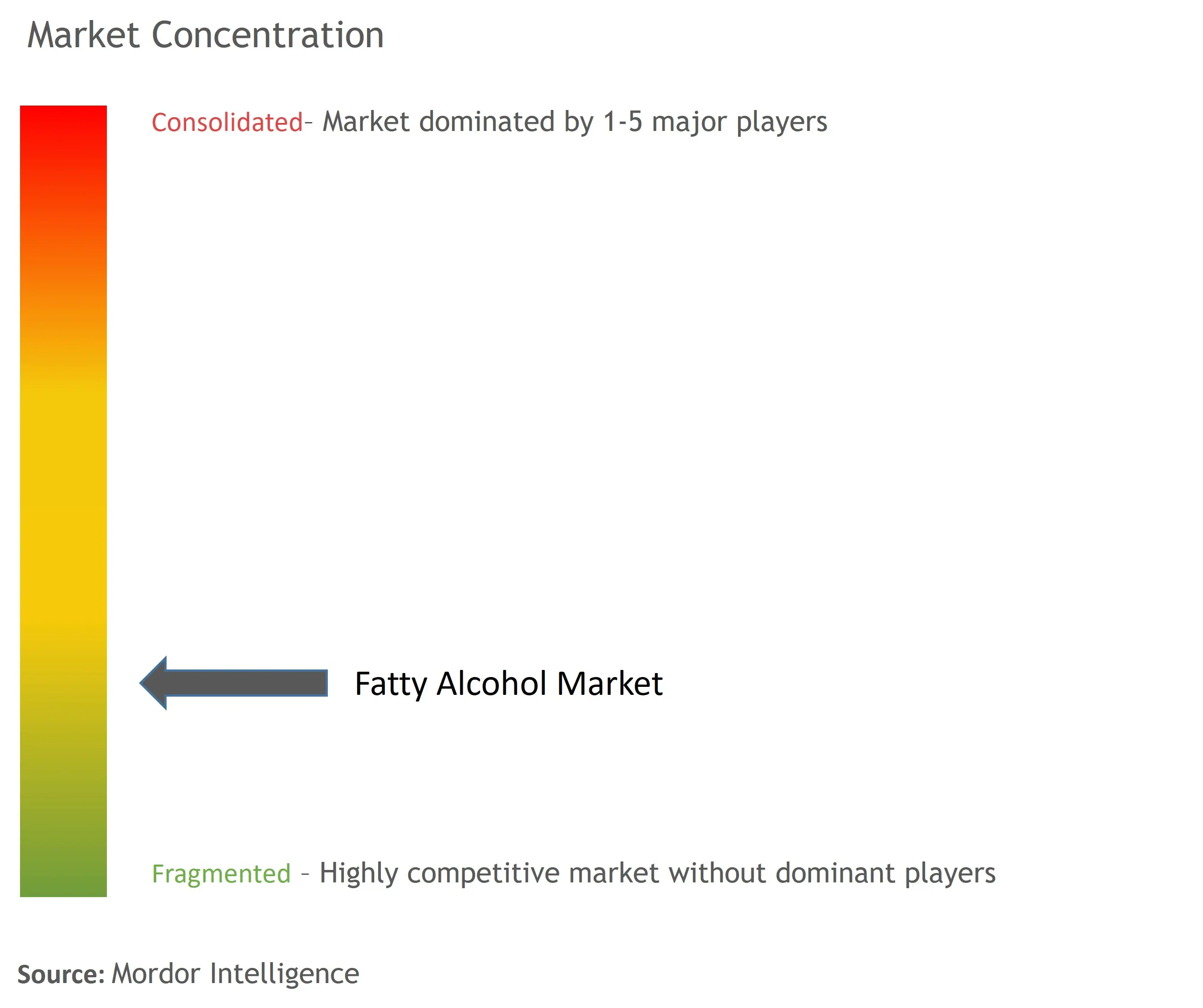
Recent Industry Developments
- March 2023: KLK K Emmerich GmbH (KLK OLEO's wholly-owned subsidiary) announced the acquisition of 90% equity interest in TemixOleo SpA. Through the acquisition, the company has strengthened its product portfolio for fatty alcohols.
- November 2022: Sinarmas Cepsa Pte. Ltd signed a memorandum of understanding (MoU) with Singaporean palm oil producer Golden Agri-Resources (a subsidiary of SinarMass) to expand bio-based chemicals production. Through the expansion, the company has increased fatty alcohol output at its site in Lubuk Gaung, Indonesia.
Global Fatty Alcohol Market Report Scope
Fatty alcohols are typically high-molecular-weight, straight-chain primary alcohols with as few as 4-6 carbons or as many as 22-26 carbons generated from natural fats and oils. The traditional sources of fatty alcohols have largely been various vegetable oils, which remain a large-scale feedstock. Fatty alcohols are also prepared from petrochemical sources. In the Ziegler process, ethylene is oligomerized using triethylaluminium followed by air oxidation.
The fatty alcohol market is segmented by type, application, and geography. By type, the market is segmented into natural sources and petrochemical sources. By application, the market is segmented into surfactants, pharmaceuticals, lubricants, personal care, foods, and other applications. The report also covers the market size and forecasts for the fatty alcohol market in 15 countries across major regions. For each segment, market sizing and forecasts are done in volume (tons).
| Natural Sources |
| Petrochemical Sources |
| Surfactants |
| Pharmaceuticals |
| Lubricants |
| Personal Care |
| Foods |
| Other Applications |
| Asia-Pacific | China |
| India | |
| Japan | |
| South Korea | |
| Rest of Asia-Pacific | |
| North America | United States |
| Canada | |
| Mexico | |
| Europe | Germany |
| United Kingdom | |
| France | |
| Italy | |
| Rest of Europe | |
| South America | Brazil |
| Argentina | |
| Rest of South America | |
| Middle East and Africa | Saudi Arabia |
| South Africa | |
| Rest of Middle East and Africa |
| By Type | Natural Sources | |
| Petrochemical Sources | ||
| By Application | Surfactants | |
| Pharmaceuticals | ||
| Lubricants | ||
| Personal Care | ||
| Foods | ||
| Other Applications | ||
| By Geography | Asia-Pacific | China |
| India | ||
| Japan | ||
| South Korea | ||
| Rest of Asia-Pacific | ||
| North America | United States | |
| Canada | ||
| Mexico | ||
| Europe | Germany | |
| United Kingdom | ||
| France | ||
| Italy | ||
| Rest of Europe | ||
| South America | Brazil | |
| Argentina | ||
| Rest of South America | ||
| Middle East and Africa | Saudi Arabia | |
| South Africa | ||
| Rest of Middle East and Africa | ||
Key Questions Answered in the Report
How big is the Fatty Alcohol Market?
The Fatty Alcohol Market size is expected to reach 4.12 million tons in 2025 and grow at a CAGR of 4.06% to reach 5.03 million tons by 2030.
What is the current Fatty Alcohol Market size?
In 2025, the Fatty Alcohol Market size is expected to reach 4.12 million tons.
Who are the key players in Fatty Alcohol Market?
PT. Ecogreen Oledochemicals, Shell PLC, Kao Corporation, Wilmar International Ltd and Sinarmad Cepsa Pte. Ltd. are the major companies operating in the Fatty Alcohol Market.
Which is the fastest growing region in Fatty Alcohol Market?
Asia Pacific is estimated to grow at the highest CAGR over the forecast period (2025-2030).
Which region has the biggest share in Fatty Alcohol Market?
In 2025, the Asia Pacific accounts for the largest market share in Fatty Alcohol Market.
What years does this Fatty Alcohol Market cover, and what was the market size in 2024?
In 2024, the Fatty Alcohol Market size was estimated at 3.95 million tons. The report covers the Fatty Alcohol Market historical market size for years: 2019, 2020, 2021, 2022, 2023 and 2024. The report also forecasts the Fatty Alcohol Market size for years: 2025, 2026, 2027, 2028, 2029 and 2030.
Page last updated on:
